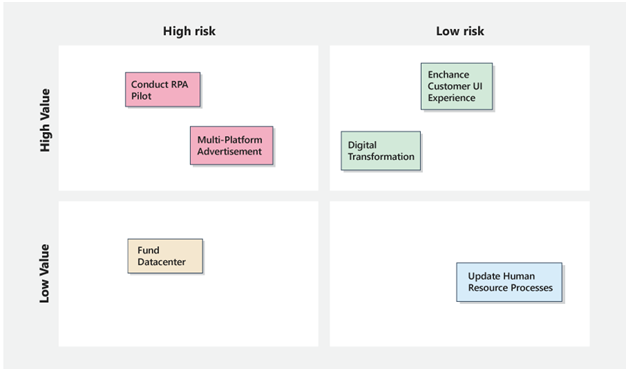Understanding Value, Risk, Mission Alignment, Funding, Staffing, Dependencies, and IT
When it comes to prioritizing projects or initiatives, having a clear framework is essential. A prioritization matrix is a powerful tool for organizing and ranking tasks based on their relative importance. However, many organizations neglect this practice, leading to inefficiencies, misaligned efforts, and missed opportunities. By leveraging prioritization effectively, leadership teams can achieve better outcomes, enhance customer satisfaction, and foster a more productive work environment.
Understanding the impact of each project can be daunting, especially in organizations with multiple departments and diverse objectives. Prioritization ensures your goals are met while highlighting how individual initiatives contribute to the broader organizational strategy.
What Is a Prioritization Matrix?
A prioritization matrix is an analytical tool used to rank and organize tasks or projects based on predetermined criteria. It helps differentiate between high-priority and low-priority tasks, providing a structured approach to managing workloads. This tool is especially valuable in resource-limited scenarios by enabling decisions that support long-term objectives.
Additionally, a prioritization matrix can compare importance and urgency, making it particularly useful for time-sensitive projects. Its versatility makes it ideal for addressing complex challenges in a simplified manner.
How Project Managers Can Use a Prioritization Matrix
For project managers, a prioritization matrix is a must-have tool for streamlining workflows. By inputting data such as cost-effectiveness, timelines, and task difficulty, managers can strategically allocate resources and distribute tasks more effectively.
Using the prioritization matrix, managers can identify critical elements of a project, delegate effectively, and ensure seamless execution. With continuous use, this process improvement tool allows for better decision-making and resource optimization, ultimately driving project success.
The 2×2 Priority Matrix
One of the most commonly used frameworks is the 2×2 priority matrix. This simple priority model divides tasks or projects into four quadrants, based on evaluations of value and risk. It is a helpful tool for visualizing priorities, building consensus, and identifying initiatives that require reevaluation.
Drawback: The 2×2 matrix’s simplicity can sometimes be a limitation, as value and risk assessments are subjective and depend on the user’s judgment.
Simplified 2×2 Priority Impact Matrix
Organizations can adapt the 2×2 model to incorporate additional dimensions like potential impacts and urgency. This evolution results in a more comprehensive assessment, allowing organizations to prioritize efficiently even as complexities grow.

Simplified 2X2 Priority – Impact MatrixEvolving the Prioritization Matrix
As organizations grow and face increasingly interconnected challenges, their prioritization frameworks must adapt. Incorporating additional dimensions like mission alignment, funding, staffing, dependencies, and IT adds critical depth to the analysis.
Key Dimensions to Consider
- Mission Alignment
Do the initiatives align with your organization’s mission, objectives, and drivers? Projects that align more closely with core goals should receive higher priority.
- Funding
Evaluate the funding required versus the available budget. Financial feasibility plays a significant role in project success.
- Staffing
Consider whether you have the required skills and human resources available to execute the project successfully.
- Dependencies
Assess both internal and external dependencies. Projects with high dependencies often carry more complexity and risk.
- IT Resources
Determine whether your IT infrastructure can support the initiative. Scalable and secure IT solutions are essential for achieving organizational objectives.
Though no single prioritization matrix fits all situations, adding these layers of analysis provides a more comprehensive understanding of your organization’s priorities. Time can also be incorporated as an optional dimension, helping align resource allocation with deadlines and expected outcomes.
The 5×5 Priority Matrix
The 5×5 prioritization matrix offers a deeper level of analysis for tackling complex issues. It allows users to evaluate projects across five axes, resulting in a well-rounded assessment that supports confident and effective decision-making.
This matrix is particularly useful for larger organizations dealing with multiple competing priorities or intricate initiatives. By analyzing across multiple dimensions, teams can arrive at more informed decisions quickly.
A Note on Execution: While the execution phase occurs later, a robust prioritization and impact analysis is critical for understanding organizational objectives and setting realistic expectations.
Why Prioritization Matters
A prioritization matrix is much more than a productivity tool; it’s a strategic necessity. It enables teams to answer critical questions such as:
- Why are we pursuing this initiative? (Mission alignment)
- What resources do we need to succeed? (Funding, staffing, dependencies, IT)
- When can we expect results? (Optional time dimension)
By answering these questions, organizations can focus on what truly matters and allocate resources effectively for sustained success.
Introducing Core-Strategy
To take prioritization to the next level, consider Core-Strategy, an enterprise-grade strategy management tool designed for modern businesses. It enables organizations to plan, implement, and evaluate progress across drivers, goals, and objectives, all while providing evidence-based decision management.
Why Choose Core-Strategy?
- A clear visual representation of priorities.
- Advanced analytics for informed decision-making.
- Alignment of resources with organizational objectives.
Whether you’re looking to create a streamlined prioritization model or strengthen collaboration, Core-Strategy has you covered.
[Sign up for a no-obligation trial today!]
About Core-CSI
Core-Cyber Security Integrators (Core-CSI) provides expertise in Program/Project Management, Enterprise Architecture, System Engineering, Business Process Re-engineering, and Cybersecurity. Trusted by the US Intelligence Community, Department of Defense, Federal, and Commercial customers, Core-CSI delivers proven results across the nation.
By adopting the right prioritization tools and strategies, your organization can elevate its performance, streamline decision-making, and achieve long-term goals with confidence.
Proprietary Information © 2022 Core-CSI LLC All Rights Reserved

